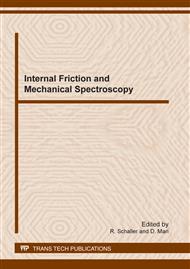[1]
I.J. Polmear. Light Alloys: From Traditional Alloys to Nanocrystals. 4th edition, United Kingdom: Butterworth-Heinemann is an imprint of Elsevier, (2006).
Google Scholar
[2]
P. Palček, J. Porubčan, D. Blažek, Z. Trojanová. Internal Friction in Commercial Aluminium Alloy AW-2007. Elsevier, Procedia Engineering 10 (2011) 1226-1231.
DOI: 10.1016/j.proeng.2011.04.204
Google Scholar
[3]
M. S. Blantner, I.S. Golovin, H. Neuhäuser, H.R. Sinning, Internal Friction in Metallic Materials, Springer (2007).
Google Scholar
[4]
C.Y. Xie, R. Schaller, C. Jaquerod. High damping capacity after precipitation in some commercial aluminium alloys. Mater. Sci. Eng. A 252 (1998) 78-84.
DOI: 10.1016/s0921-5093(98)00683-2
Google Scholar
[5]
M. Goncalves, M.G. Martins, W.Z. Misiolek, W.H. Van Geertruyden. Homogenization and hot workability of alloy AA2014. Mater. Sci. Forum 396-402 (2002) 393-398.
DOI: 10.4028/www.scientific.net/msf.396-402.393
Google Scholar
[6]
S. Koch and H. Antrekowitsch. Alloying Behaviour of Cu, Mg and Mn in Lead-free Al-Cu Based Alloys Intended for Free Machining, BHM 156 (2011) 22-27.
DOI: 10.1007/s00501-011-0621-z
Google Scholar
[7]
M. Panušková, E. Tillová, M. Chalupová. Relation between mechanical properties and microstructure of Al-cast alloy AlSi9Cu3, Strength of Materials 40, 1 (2008) 98-101.
DOI: 10.1007/s11223-008-0026-8
Google Scholar
[8]
C. Bathias, P. C. Paris. Gigacycle Fatigue in Mechanical Practice, M. Dekker, New York (2005).
Google Scholar
[9]
J. Z. Yi, C. J. Torbet, Q. Feng, T. M. Pollock, J. W. Jones. Ultrasonic fatigue of a single crystal Ni-base superalloy at 1000 °C. Mat. Sci. Eng. A 443 (2007) 142-149.
DOI: 10.1016/j.msea.2006.08.028
Google Scholar
[10]
K. Nishiyama, R. Matsui, Y. Ikeda, S. Niwa, T. Sakaguchi. Damping properties of a sintered Mg–Cu–Mn alloy. J. Alloy Comp. 355 (2003) 22-25.
DOI: 10.1016/s0925-8388(03)00256-1
Google Scholar
[11]
H. Jiang, M. Li. Microscopic observation of cold-deformed Al-4Cu-Mg alloy samples after semi-solid heat treatments. Mater. Char. 54 (2005) 451-457.
DOI: 10.1016/j.matchar.2005.01.010
Google Scholar
[12]
M. Gabbay, A. Vincent, G. Fantozzi. Amplitude-dependent internal friction due to thermomechanical breakaway of dislocations from pinning point defects. Phys. Status Solidi A 100 (1987) 121-137.
DOI: 10.1002/pssa.2211000114
Google Scholar
[13]
R. B. Schwarz. Amplitude-dependent internal friction calculations for dislocations in alloys Acta Metall. 29 (1981) 311-323.
DOI: 10.1016/0001-6160(81)90158-9
Google Scholar
[14]
N. A. Tyapunina and V. V. Blagoveshchenskii. Dislocation Behaviour and Multiplication under Ultrasound. Phys. Status Solidi A 69 (1982) 77-83.
DOI: 10.1002/pssa.2210690105
Google Scholar
[15]
E. K. Naimi The Amplitude Dependence of Internal Friction and the Young's Modulus Defect in Solids Due to Anharmonism of Dislocation Motion at Low Vibration Amplitudes, Phys. Status Solidi A 72 (1982) 825–832.
DOI: 10.1002/pssa.2210720248
Google Scholar
[16]
A. Vincent and J. Perez. Low-Temperature Point Defects and Dislocation Study from Megahertz Ultrasonic Measurements in Aluminium, Il Nuovo Cimento – B. 33 (1976) 147-154.
DOI: 10.1007/bf02722481
Google Scholar
[17]
A. Granato and K. Lücke, Theory of Mechanical Damping Due to Dislocations, J. Appl. Phys. 27 (1956) 583.
DOI: 10.1063/1.1722436
Google Scholar
[18]
A. V. Granato, K., Lücke: Application of dislocation theory to internal friction phenomena at high frequencies. J. Appl. Phys. 27(1956) 789-805.
DOI: 10.1063/1.1722485
Google Scholar


